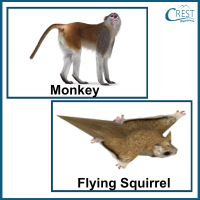1. Which of the following option explains the purpose of hibernation for animals?
a) Animals hibernate to protect themselves from predators.
b) Animals hibernate to save food and water.
c) Animals hibernate to sleep for a long time during winter.
d) Animals hibernate to conserve energy and survive the cold winter months.
Answer: d) During hibernation, animals can save their energy and withstand the lack of food and challenging winter conditions by going into a deep sleep. This allows them to make the most of their limited energy stores and survive through the tough times when there isn't much to eat or when the environment is harsh.
2. Match the following.
| Column I |
Column II |
| 1. Camouflage |
A) Physical barrier against predators |
| 2. Thick fur |
B) Structures for protection against predators |
| 3. Spines or quills |
C) Hard coverings to shield against predators |
| 4. Armour |
D) Blending with the surroundings |
a) 1:D, 2:A, 3:B, 4:C
b) 1:A, 2:D, 3:C, 4:B
c) 1:A, 2:D, 3:B, 4:C
d) 1:D, 2:A, 3:C, 4:B
Answer: a) Camouflage: Blending with the surroundings
Thick fur: Physical barrier against predators
Spines or quills: Structures for protection against predators
Armour: Hard coverings to shield against predators
3. In which environment would white-coloured fur be most advantageous for an animal's protection?
a) Desert
b) Rainforest
c) Polar region
d) Grassland
Answer: c) The polar region is a place with lots of snow and ice. The white fur helps animals blend in with the snow, providing them with effective camouflage against predators and allowing them to sneak up on their prey unnoticed.
4. Which animal has the following adaptations to survive in their habitat?
i) Long eyelashes and thick eyebrows.
ii) Big, wide feet and fat stored in their hump.
iii) Closed nostrils and covered ears.
a) Kangaroo
b) Camel
c) Fennec fox
d) Musk oxen
Answer: b) The animal with the described adaptations is the camel.
i) Long eyelashes and thick eyebrows help protect their eyes from sand and the hot sun.
ii) Big, wide feet and fat stored in their hump aid in walking on sand and provide energy during food and water scarcity.
iii) Closed nostrils and covered ears prevent sand from entering their respiratory system.
5. What is the point of similarity between the animals shown in the picture?

a) Both of them have claws and tails that can grip branches.
b) They both live in the desert.
c) They are both arboreal animals.
d) Both of them can camouflage.
Answer: c) Both monkeys and flying squirrels are examples of arboreal animals, meaning they live and move in trees.


